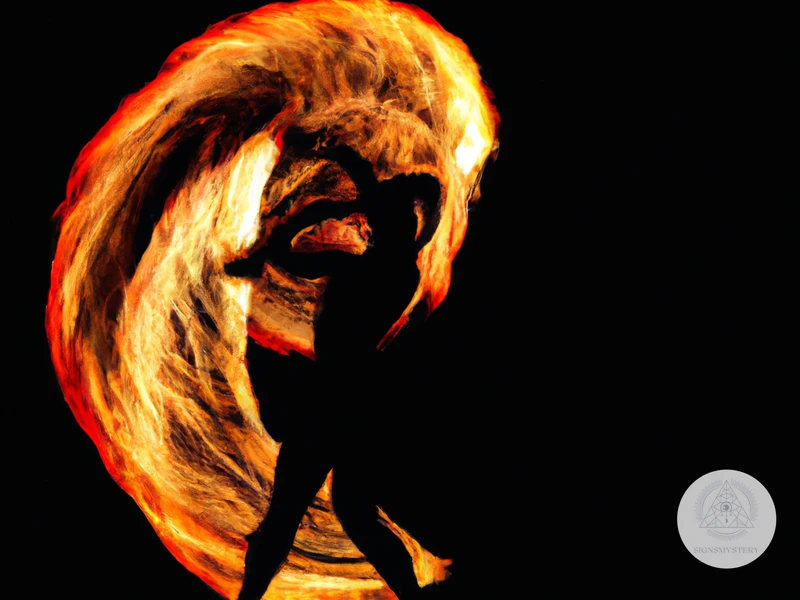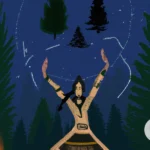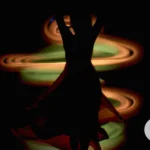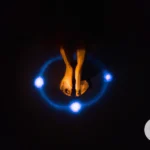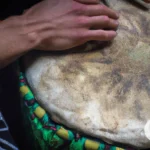Fire dancing is a mesmerizing art that involves spinning flames and body movements in a rhythmic dance. It has become increasingly popular in recent years, not only as a form of entertainment but also as a spiritual practice. The combination of fire and movement has a deep and meaningful connection in many cultures, from ancient shamanic rituals to modern performances. This article delves into the history and symbolism of fire dancing, as well as its connection to shamanism and modern-day communities. We will also cover important safety precautions to take when participating in or watching fire dancing performances. Join us on this journey to explore the sacred art of fire dancing and its mystical appeal.
The Spiritual Significance of Fire Dancing
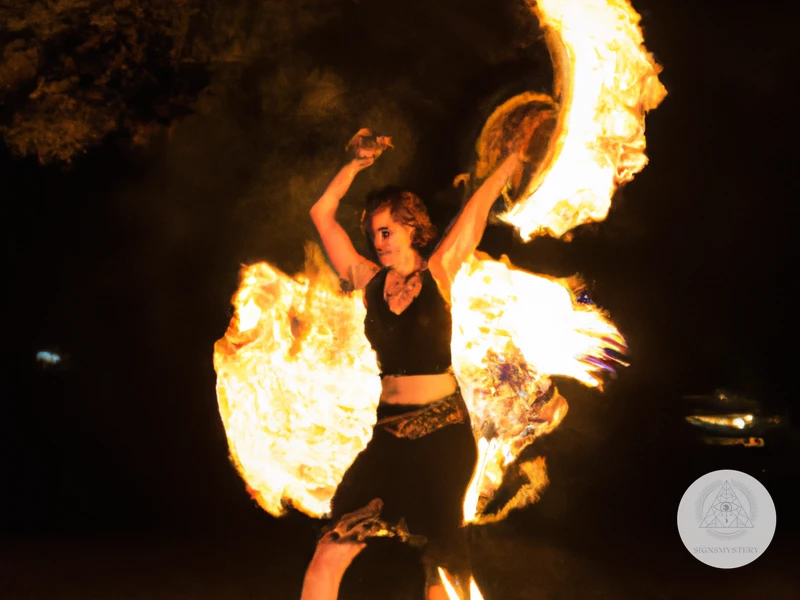
Fire dancing has always had a deep spiritual significance in many cultures around the world. The act of dancing with fire is often associated with bravery, strength, and at times, a connection to the divine. In some cultures, fire dancing is a form of spiritual purification and has been used as a tool for healing and Shamanic rituals. The energy created by dancing with fire is said to cleanse and renew one’s spirit, allowing for a deeper connection to oneself and the universe. Many believe that the practice of fire dancing can awaken the kundalini energy located at the base of the spine, leading to a spiritual awakening. Similar to other indigenous dances with spiritual significance, such as the ecstatic dance and the African dance, fire dancing has the power to transcend the physical realm and connect a dancer to a higher spiritual consciousness.
History of Fire Dancing
The origins of fire dancing are shrouded in mystery, but there are some theories about its history. Some historians believe that fire dancing started in ancient Polynesia as a form of ritual worship. It is said that the dancers would use the hypnotic rhythm of their movements and the heat of the flames to enter a trance-like state and communicate with the gods.
Others believe that fire dancing has its roots in ancient India, where it was practiced as a form of whirling dervish meditation. It was said that the dancers would twirl in a circle while holding a torch, which symbolized the divine spark of creation. This dance was also used as a form of healing and was believed to be a way to connect with the divine.
Fire dancing is also a part of indigenous tribal dances around the world. In some cultures, the dance is used to celebrate the changing of the seasons or as a form of rain ritual. In other cultures, it is used to honor the ancestors or as a way to communicate with the spirit world.
Regardless of its origins, fire dancing has been practiced for centuries and continues to be a popular form of expression and ritualistic dance today. Its connection to shamanism and spirituality has given it a deeply mystical and sacred meaning, and it remains a powerful symbol of human connection to the divine.
Fire Dancing in Different Cultures
Fire dancing is ancient and has its roots in cultures all around the world. It no longer belongs to just one culture or continent; it has captivated the hearts of people everywhere.
South Pacific
In the South Pacific, the Maori people of New Zealand perform a fiery dance called the Haka. This dance is a cultural tradition, a battle cry, and a form of storytelling. Women performers practice poi dancing, which involves spinning poi balls around their bodies and creating patterns of fire in the night.
North America
In North America, the Hopi tribe of Arizona performs the Fire Dance as a part of their kachina ceremony, which is dedicated to rain and fertility. The dance involves dancers moving over hot coals, with the belief that this will bring them closer to the spirits and the divine world.
Africa
In Africa, the Himba tribe of Namibia performs a fire dance called the Haupia. This dance is an ancestor ritual performed only by men. Practitioners make a small fire and jump in and out of the flames while chanting and clapping.
Europe
In Europe, people perform similar dances under different names, such as the Fire Dance of Spain and the Beltane Fire Festival in Scotland. They believe that these dances purify, protect, and create new life energy.
Fire dancing, in all its forms, has always been recognized as a way to connect with the divine world and the spirits. It has been incorporated into traditional rituals and ceremonies of the different cultures mentioned above and is still practiced today. Fire dancing has the power to transcend culture and language to bring people together. If you’re interested in learning more about other ritualistic dances, check out ecstatic dance shamanic healing and spiritual African dance shamanism.
The Symbolism of Fire
Fire has been considered a sacred element throughout human history. It represents power, light, warmth, and transformation. In many cultures, fire symbolizes the divine force that gives life to everything in the world.
In ancient Greek mythology, Prometheus stole fire from the gods and gave it to humans, thus giving them the power of creation. In Hinduism, fire represents the eternal witness and the destroyer of all impurities. In Christianity, the Holy Spirit is often depicted as tongues of fire.
Fire is also commonly associated with the sun, which is seen as the source of all life and energy in many cultures. The sun’s light and heat provide the energy for all life on Earth, and fire similarly provides warmth and light. Fire also has a transformative power, turning wood into ash and allowing for new growth.
In fire dancing, the flames themselves take on a symbolic meaning. The movement of the fire portrays the intensity and passion of the dancer, and the sparks that fly from the flames represent the sparks of creativity and transformation. The fire can also be seen as a spiritual guide, leading the dancer towards greater understanding and enlightenment.
In shamanic traditions, fire is often used as a tool for purification and healing. The fire is seen as a transformative force that can burn away negative energies and facilitate spiritual growth. Through the use of fire, shamans are able to connect with the spirit world and journey to other realms.
Fire holds great symbolic significance and has been revered in many cultures throughout history. Its power and transformative nature make it an important element in spiritual and creative practices alike.
Shamanism and Fire Dancing
Fire dancing has deep roots in shamanic traditions and has been used in various cultures for spiritual and healing purposes. In shamanism, fire is viewed as a powerful tool for transformation and enlightenment. The training and practice of fire dancing requires discipline, focus, and an understanding of the energy of fire. Shamans believe that fire dancing can induce altered states of consciousness and aid in achieving a connection with the spiritual world. Some shamanic practitioners perceive fire dancing as a way to communicate with the spirits and receive guidance from them. Additionally, fire dancing can be seen as an act of purification, where the dancer releases any negative energy or emotions and harnesses the power of the fire for positive transformation. The synergy between fire dancing and shamanism continues to inspire practitioners around the world.
Shamanic Roots of Fire Dancing
The practice of fire dancing has its roots in shamanism, which is one of the oldest traditions in the world. The shamanic belief system centers around the idea that the physical and spiritual worlds are interconnected, and that every individual has the power to connect with the spiritual realm.
Shamans would use a combination of dance, chanting, and other techniques to enter altered states of consciousness in order to communicate with the spiritual realm. Fire was a popular tool used in these practices, as it was believed to have a purifying quality that could help to connect the shaman with the spiritual realm.
Fire dancing, as a form of shamanic practice, is thought to have originated in ancient Polynesia. Polynesian shamans would dance around fires to connect with their ancestors and ask for their guidance. They believed that fire was a living entity with its own consciousness, and that by dancing around it, they could tap into this consciousness and communicate with the spirits.
As the practice of fire dancing spread to other cultures, it evolved and took on new meanings. In some cultures, fire dancing was used as a form of healing, while in others it was a way to connect with the elements. Regardless of its specific meaning, fire dancing has always been deeply rooted in spiritual practices.
Today, many fire dancers continue to draw inspiration from shamanic traditions and use fire as a tool for spiritual growth and self-discovery. Whether they are using fire to communicate with the spiritual realm or simply as a way to express themselves creatively, fire dancers continue to cultivate the shamanic roots of this ancient art form.
Fire as a Tool for Shamanic Journeying
Fire has long been recognized as a potent tool for shamanic journeying. In this practice, fire is used to enhance a shaman’s ability to enter a trance state and connect with the spirit world. There are several different techniques used to achieve this state, including gazing into the flames, drumming, and dancing around the fire.
Technique | Description
———-|————
Gazing | Gazing into the flames of a fire is a common technique used in shamanic journeying. The flickering of the flames can help focus the shaman’s mind and induce a trance state. This technique is often used in combination with other methods, such as drumming or chanting.
Drumming | Drumming is another common technique used in shamanic journeying. The steady beat of a drum can help quiet the mind and allow the shaman to enter a deep meditative state. In combination with fire, drumming can create a powerful energy that enhances the shaman’s spiritual connection.
Dancing | Dancing around the fire is another technique used in shamanic journeying. This method can be highly effective, as it engages the body and mind in the process. Moving to the rhythm of the drumbeat and the flicker of the flames, the shaman can enter a state of trance and connect with the spirit world.
Fire is not only a tool for shamanic journeying, but it is also seen as a symbolic representation of transformation. The transformative power of fire is associated with spiritual growth and rebirth, which is a significant aspect of the shamanic journey. Fire is an essential element of shamanic practices and rituals in many cultures around the world.
The Use of Fire Dancing in Shamanic Ceremonies
The use of fire dancing in shamanic ceremonies is a sacred and powerful practice that has been utilized by cultures around the world for centuries. Fire is seen as a transformative force, capable of burning away negativity and promoting physical, emotional, and spiritual healing.
In many shamanic traditions, fire dancing is used to connect with the spiritual realm and receive messages from the divine. This is often done through trance-like states induced by the rhythmic movement of the dancers and the hypnotic effect of the flames.
The fire is often created in a ritualistic manner, with different woods and herbs chosen for their specific properties and spiritual significance. The fire is then tended to throughout the ceremony, with the flames and smoke used to cleanse and purify the space.
As the dancers move around the fire, they may carry special objects or wear symbolic clothing to represent different aspects of the spiritual world. The dance itself is a form of prayer, a way of connecting with the divine and channeling its energy into the physical world.
The use of fire in shamanic ceremonies is not without risk, as working with such a powerful element requires caution and respect. The dancers must be skilled and trained in fire safety, and precautions must be taken to ensure that the fire does not become uncontrollable.
The use of fire dancing in shamanic ceremonies is a profound and transformative practice that connects participants with the spiritual realm and promotes healing and transformation. It is a powerful testament to the ancient wisdom and spiritual practices of our ancestors, and continues to be an important part of many cultures and traditions around the world.
Modern Fire Dancing Communities
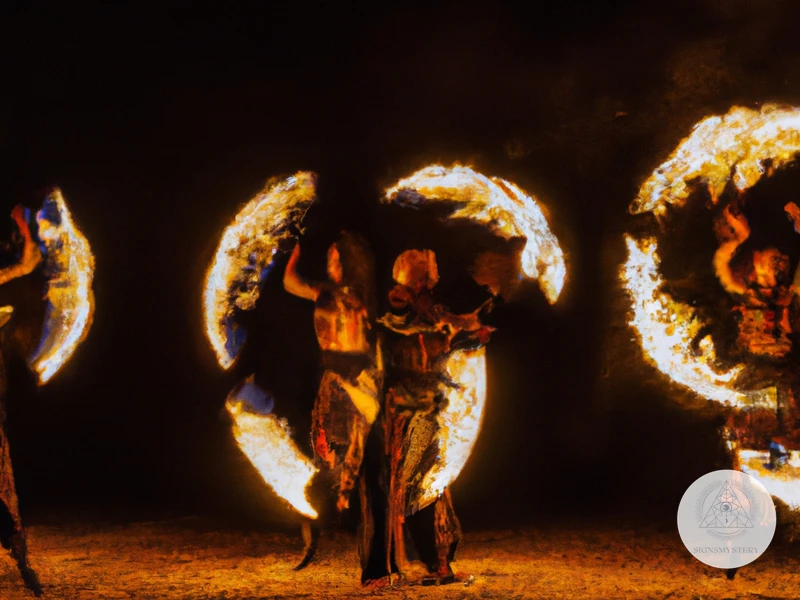
Fire dancing has evolved from being a spiritual practice in ancient times to a modern form of self-expression and entertainment. Nowadays, there are numerous fire dancing communities around the world where people come together to share their passion for movement, music, and fire. These communities can range from small groups of friends practicing in a backyard to larger, organized events such as festivals and performances. Fire dancing allows individuals to explore their creativity and push their physical boundaries while connecting with others who share their love
Subscribe to Our Newsletter
Sign up to receive the latest news and updates.
Fire Dancing as a Form of Self-Expression
Fire dancing, as a form of self-expression, allows individuals to connect with their inner selves and express themselves in a unique way. The movement of the flames can be mesmerizing, and the dancer can use their body to manipulate the flames to create a beautiful and captivating performance. Fire dancing can be seen as a form of art and a way to express oneself through movement, creativity, and unique skills.
Fire dancing performances are often used as a platform for self-expression and can be seen in many different settings, from community events to festivals and even nightclubs. Fire dancers often use their performances as a way to communicate their emotions and inner thoughts to their audience. Through choreography and dance movements, the dancer can express a range of emotions from joy and exhilaration to sorrow and pain.
Fire dancers use different styles and techniques to express themselves through their performances. Some dancers prefer to use fast, dynamic movements to illustrate energy and enthusiasm, while others use slower, more fluid movements to communicate serenity and calmness. Each dancer can incorporate their unique style and personality into their movements, creating their unique expression of self.
Fire dancing is a way to break free from societal norms and express oneself freely without the fear of judgement. For many people, fire dancing is a way to let go of their inhibitions and express themselves in a unique and authentic way. Through the use of flames and movement, fire dancers can unleash their creativity and express themselves in a way that is both empowering and liberating.
Fire dancing is a form of self-expression that can be incredibly empowering and lifting experience. By allowing oneself to be free and creative in their movement, one can experience a deeper connection to themselves and their inner spirit. Fire dancing is a beautiful and unique form of art and self-expression that has captivated audiences for centuries and is still an evolving form of artistic expression today.
Professional Fire Dancing Performances and Entertainment
Professional fire dancing performances and entertainment have gained popularity in recent times. Fire dancers perform at various events like music festivals, corporate events, private parties, and even weddings. These performances are not only visually stunning but also provide a unique experience for the audience.
Fire performers usually choreograph their routines to music, and their movements are a blend of dance styles like ballet, modern and acrobatics. Fire dancing can incorporate a wide range of fire tools like poi, staff, fans, and fire eating.
Most fire dancers have undergone extensive training to ensure safety measures while performing with fire. Even so, there are risks involved, and performers and event organizers need to take certain precautions to minimize them. These precautions include using appropriate safety gear like fireproof clothes, having fire extinguishers nearby, and performing in a safe and designated area.
Professional fire dancing performers bring a sense of excitement and awe to events. They often have an extensive portfolio of performances and can be hired for everything from a short solo act to a full-length show. Some of the most popular events for fire dancing performances include:
- Music Festivals: Many music festivals hire fire dancers for performances in the evening as a way to add to the festival atmosphere and provide entertainment for attendees.
- Corporate Events: Fire dancing performances can add an element of excitement to corporate events and are often used as a way to capture the attention of attendees before a keynote speaker or during intermissions.
- Weddings: Some couples choose to hire fire dancers as entertainment for their wedding receptions, providing a unique and memorable experience for their guests.
- Private Parties: Fire dancers can also be hired for smaller private parties, providing a unique form of entertainment for guests.
Professional fire dancing performances and entertainment are not only visually stunning but also provide audiences with an experience they won’t soon forget. By taking appropriate safety measures, performers and event organizers can ensure a safe and memorable performance.
Precautions and Safety Measures
When it comes to fire dancing, it is important to remember that safety should always be a top priority. As mesmerizing as the performance may be, there are precautions that need to be taken in order to avoid any accidents or injuries. Here are some safety measures that fire dancers and event organizers should keep in mind:
1. Proper training and experience: Fire dancing should never be attempted without proper training and experience. It is crucial for fire dancers to fully understand the techniques and safety precautions involved before performing with fire. This includes understanding the chemistry of fire and the proper use and storage of fuel. It is also important to practice in a safe and controlled environment before performing in front of an audience.
2. Safety equipment: Fire dancers should always wear appropriate safety equipment, such as fire-resistant clothing, gloves, and goggles. Fire blankets and fire extinguishers should also be readily available in case of an emergency.
3. Fire safety protocols: It is important to establish fire safety protocols at any event where fire dancing is taking place. This includes designating a safety officer who is responsible for monitoring the performance and ensuring all safety measures are being followed. The performance area should also be clearly marked and kept clear of any flammable materials.
4. Fuel safety: The fuel used for fire dancing should be stored in a cool, dry place, away from any sources of heat or flame. It is also important to use only approved fuels and to never mix fuels or add accelerants. It is important to read and follow the manufacturer’s instructions for use and disposal of fuel.
5. Weather conditions: Fire dancing should never take place in windy or otherwise hazardous weather conditions. It is important to monitor the weather and make adjustments to the performance schedule or location if necessary.
Fire dancing can be a beautiful and captivating art form, but it is important to remember that safety should always come first. By following proper precautions and safety measures, fire dancers can perform safely and confidently, while still creating an unforgettable experience for audiences.
Conclusion
In conclusion, fire dancing is a sacred art that has been practiced for centuries. It holds a deep spiritual and cultural significance in many cultures and is still widely performed today. Through fire dancing, individuals can connect to the power and symbolism of fire, and also tap into the practice of shamanism for spiritual and personal growth.
While fire dancing can be a beautiful and powerful expression of art, it also requires a high degree of caution and safety measures. Fire performers need to be properly trained and equipped with fire-resistant clothing, fire extinguishers, and other necessary safety equipment. Safety should always be the top priority when practicing fire dancing.
Despite the potential dangers, the art of fire dancing continues to evolve and grow in modern times. It has become a popular form of self-expression and entertainment, with communities of fire dancers emerging all over the world.
As we continue to explore and celebrate the sacred art of fire dancing, we must also acknowledge and respect its history, cultural significance, and spiritual roots. Through a combination of skill, creativity, and mindfulness, fire dancing can be a powerful tool for personal and collective transformation. It is indeed a mesmerizing and profound practice, filled with beauty, mystery, and wonder.
Frequently Asked Questions
Why is fire dancing considered a sacred art?
Fire dancing is considered a sacred art because of the deep spiritual significance it holds for many cultures around the world. It is often used in religious and shamanic ceremonies to connect with the divine, honor ancestors, and symbolize the cycle of life and death.
What is the history of fire dancing?
Fire dancing has been practiced for centuries as a form of ritual and entertainment in many cultures, including Polynesian, Indian, and African. It is believed to have originated in the South Pacific, where it was used as a form of storytelling and spiritual connection with the elements.
What does fire symbolize in fire dancing?
Fire is often seen as a symbol of transformation, purification, and renewal in fire dancing. It represents the boundaries between life and death, the physical and spiritual worlds, and is often used to connect with the divine and honor ancestors.
What are the shamanic roots of fire dancing?
Fire dancing has been used by shamans as a tool for spiritual connection and journeying for centuries. It is believed that the trance-like state induced by fire dancing, combined with the heat and light of the fire, can help shamans enter into altered states of consciousness and connect with the spiritual realm.
How is fire used in shamanic ceremonies?
Fire is often used in shamanic ceremonies to honor the spirits, ancestors, and deities, as well as to create a sacred space for journeying and spiritual connection. It is also used for purification, protection, and to symbolize the transformative power of the spirit world.
What are the safety measures for fire dancing?
Fire dancing can be dangerous if proper safety measures are not taken. Some important precautions include wearing protective clothing, having a designated safety spotter, using non-toxic fuel, and practicing in a designated fire-permitted location.
What is the significance of fire dancing in modern culture?
Fire dancing has become a popular form of self-expression and entertainment in modern culture, with many people incorporating it into festivals, concerts, and performances. It is often seen as a way to connect with the elements, explore the limits of the human body, and showcase creative expression.
What are the benefits of fire dancing?
Fire dancing can provide many physical and mental benefits, including increased coordination, flexibility, and strength. It can also help to improve mental focus, reduce stress, and promote a sense of community and spiritual connection.
What are some common fire dancing props?
There are many different props used in fire dancing, including poi, staffs, hoops, fans, and swords. Each prop has its own unique style and can be used to create different visual effects and patterns with the fire.
Can fire dancing be used for therapeutic purposes?
Fire dancing can be used as a form of therapy, particularly for those who are looking to explore their spirituality and connect with the elements. It can also be used to help individuals overcome fear and build self-confidence, as well as to promote physical and mental well-being.

